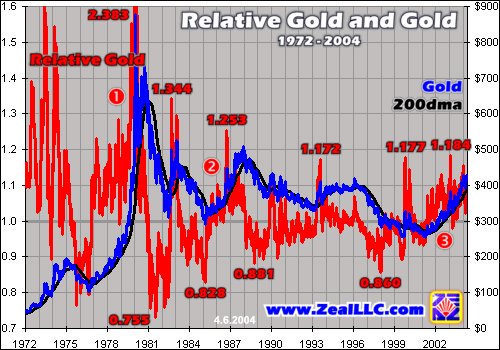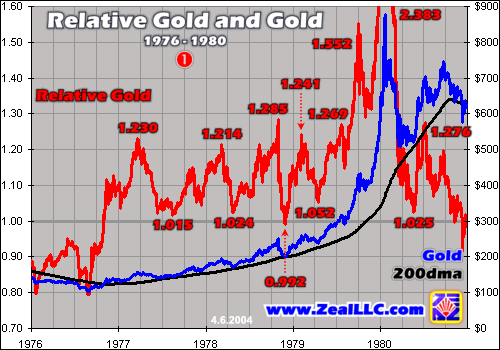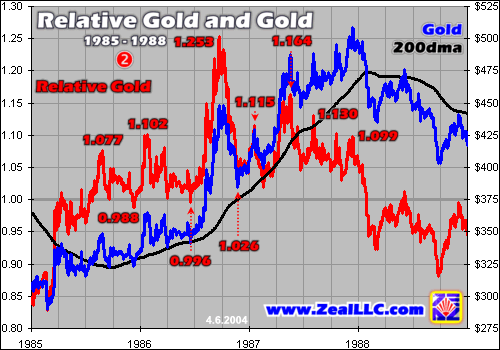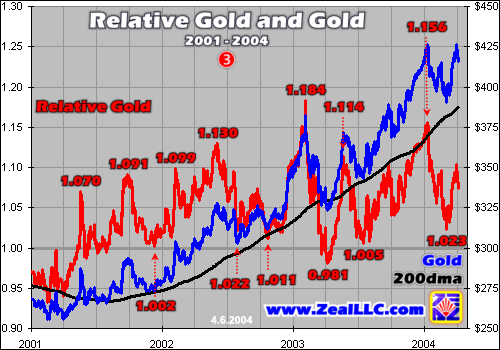|
|
|||||||
|
|
|
|
|
|
|
|
|
|
Relative Gold Bulls Adam Hamilton April 9, 2004 3166 Words
Analyzing the gold market is more challenging than analyzing the general stock markets. While countless speculation indicators have sprung up around the enormous interest in trading stocks, the far smaller gold world lacks these nifty technical tools.
In stocks, for example, there are implied volatility indices that effectively quantify popular greed and fear, there are bullish percent indices that reveal technical strength or decay under the surface, and there are price-to-earnings ratios and dividend yields which provide an absolute yardstick of the relative expensiveness or cheapness of stocks. Unfortunately gold lacks all of these powerful tools.
Just like stocks, over the long-term international supply and demand ultimately drives the gold price. But, also just like stocks, over the short-term the primary driver of gold is emotion and speculation. Sometimes these long-term and short-term driving forces agree and push gold in the same direction, while other times they do not, leading to tradable countertrend moves.
In order to better identify these short-term driving forces in real-time so we can profitably trade upon them, I have been trying to develop technical gold trading tools in the recent years. Some have been so worthless that I don’t even bother writing about them publicly, while others have thankfully proven to be quite useful. One in particular has really captured my attention since the gold consolidation began a few months ago.
I call this indicator Relative Gold, or rGold for short. Like the majority of technical indicators it is simple in concept and easy to calculate, but it offers many additional insights not readily apparent on a standard gold price chart alone. Relative Gold is computed by dividing the closing gold price by gold’s 200-day moving average.
The idea behind rGold is that gold’s price relative to its 200dma can help speculators discern when the probability for a short-term turn in the gold price is high or low. The 200dma is one of the most important lines in all of technical analysis and forms the foundation for rGold. 200dmas are extremely crucial technical levels for several reasons.
In any major trend, bull or bear, countertrend pullbacks to the 200dma of the primary long-term trend are expected and normal. Due to its very mathematical nature, the slow 200dma is the baseline off of which most secular trends flow and ebb. If you are in a bull market and long-term fundamentals are still in your favor, any close convergence of a price with its 200dma usually marks a fantastic buying opportunity.
By averaging about 40 weeks worth of trading days, 200dmas are also very unyielding and are difficult to push around. Big daily price movements driven by popular emotion have a minimal impact on the rock-solid 200dmas. As such, these slow-moving and formidable long moving averages provide an excellent reference point from which to measure prices.
Relative Gold, therefore, provides one simple number that tells us how far above or below its key 200dma that gold happens to be trading at any given time. It also provides a perfectly comparable constant-percentage reading over time. Whether gold is trading at $100 or $1000, an rGold reading of 1.02 always indicates that gold is 2% above its 200dma. Differing price scales over time cannot skew this indicator.
A high rGold reading indicates that gold is stretched far above its major 200dma support so the probability of a correction or consolidation is high. A low rGold reading indicates that gold has retreated back near its major 200dma bull-market support and is probably due to surge higher in a new upleg in the months ahead. Thus Relative Gold effectively shows the current dearness or cheapness of gold in pure technical terms, very valuable information for speculators to possess.
While we have already been using rGold a great deal to analyze gold’s current bull market, quite a few speculators including I have been wondering how rGold acts throughout modern gold history. Did rGold work the same way in the past? What can we learn from its behavior in earlier bull markets? In order to gain some insights into these important questions, this week we are examining over three decades worth of rGold data stretching back to 1972.
Our charts this week include the daily gold price, gold’s 200dma, and the Relative Gold numbers obtained by dividing gold by its 200dma. This long-term dataset is continuous-contract futures based, so the rGold numbers in our current gold bull differ slightly from those obtained via spot gold prices over the last few years. The best place to begin our explorations is to examine the grand strategic snapshot of all the data at once.
The last few decades really have been extraordinary for the Ancient Metal of Kings! In the 1970s the greatest gold bull of modern history erupted right after Washington unceremoniously severed all gold backing from the US dollar. This gold bull grew into a speculative mania culminating in a spectacular gold bubble. The first half of the 1980s witnessed the shockwaves of the gold markets trying to adjust to the new monetary realities in the bubble aftermath.
Once these massive post-bubble ripples cascaded through the system, the next decade and a half or so were marked by a secular bear trend in gold, albeit punctuated by strong bull markets. For you statistics junkies, the entire period of time shown above encompasses over 8000 trading days. This truly gigantic dataset offers an outstanding opportunity to investigate the utility of Relative Gold over decades.
Not surprisingly, the most volatile rGold numbers on record occurred in the decade after the cataclysmic 1971 dollar/gold default. The terrible decision to remove all gold backing from the US dollar in 1971 and render it a totally fiat-paper currency supported by nothing but faith in Washington marked the beginning of the end of the US dollar’s global hegemony. Gold faithfully bore witness to this atrocity.
Since the gold backing of the dollar has already been tossed into the trash heaps of history, the events of the 1970s cannot be repeated. Without any gold standard whatsoever in place today, there is no way it can be taken away again. As such, it is important to view the decade after the 1971 infamy as a one-time event not necessarily predictive of future markets. The extreme rGold numbers witnessed during this adjustment were the exception and not the rule.
These 1970s dislocations unleashed massive fiat-currency inflation which helped fuel the gold bubble that dominates this chart. Both the all-time high and all-time low rGold readings were registered during the gold bubble and its subsequent crash over two decades ago. At its very apex, gold was trading at 2.383x its 200dma, amazing! As it crashed after this incredible top, the noble metal plunged to 0.755x its 200dma. Such breathtaking extremes are unlikely to be witnessed again in rGold unless a future gold speculative mania leads to another parabolic bubble blowoff and subsequent crash.
After the shockwaves of the gold bubble and its aftermath passed, rGold’s volatility profile has been much tamer. The highest rGold reading in the last couple decades was 1.253, and the lowest 0.828. These numbers are important as they define a multi-decade relative trading range for gold. The metal has tended to bounce between being priced at 125% of its 200dma at best and only 83% of its 200dma at worst. A break out of this macro range in the coming years would certainly be a very noteworthy event.
Since we are using rGold as a technical indicator in today’s gold bull, I am most interested in seeing how it performed in past major gold bulls. On the chart above, there are three major gold bulls labeled with the red numbers. The first was the Great Bull of the late 1970s, which evolved into the infamous gold bubble. The second was a normal cyclical gold bull in the mid 1980s, and the third is our current specimen today.
Our next three charts zoom in and detail each of these major gold bulls in turn. By analyzing how rGold performed in past major gold bulls, we can gain a far better idea if what we have experienced in our current bull market is “normal” in light of past precedent. The historical data will also be valuable to help calibrate our current rGold indicator buy and neutral levels.
While there is a big difference between a normal bull market in gold and a gold bubble, I still wanted to look at the late 1970s superbull. Since all bubbles are essentially bull markets that careen out of control to the upside as the public starts chasing them late in the game, the early years of a superbull look strikingly similar to a typical bull market.
If we divide this chart in two with a split near mid-1979, the left-side bull and the right-side bubble can be analyzed separately. The line of demarcation between a strong secular bull and a full-on speculative-mania bubble is the point where a price begins climbing vertically. Prior to this initial parabolic ascent, a superbull behaves much like a normal bull market.
In the bull shown above before the mid-1979 birth of the bubble, the interaction between gold and its 200dma perfectly captures just why the Relative Gold indicator is so useful. Every major gold upleg launched at an rGold low, and every major consolidation or correction was born at a high rGold reading. As speculators, we want to buy gold and gold vehicles when rGold is low and sell or prepare to get stopped out when rGold is high. The rules for trading this indicator are as simple as the indicator itself.
From the launch of this gold bull in mid 1976 to its metamorphosis into a bubble in mid 1979, every major low was marked by gold bouncing near its strong 200dma support. The average rGold level at the four interim bottoms shown above was 1.021. Interestingly, even during the gold crash following the bubble gold bounced near its 200dma when rGold hit 1.025 in mid 1980! Thus, a gold speculator of twenty-five years ago would have been well served by buying only when gold contracted down to near 2% above its 200dma.
Prior to the gold bubble, the average interim gold top appeared when rGold averaged 1.248. A similar level, 1.276, even marked the initial top after the bounce following the gold crash of early 1980. A gold speculator would have wanted to sell, throw short, or go neutral and tighten stops when gold approached levels about 25% above its 200dma in the late 1970s.
Personally, I lean towards going neutral at high rGold readings rather than selling outright once a gold bull has been running for a few years. The reason is evident above. It is impossible to predict exactly when a secular bull in gold will capture the public’s imagination and morph into a bubble. An established gold investor certainly does not want to sell outright when a bubble is on the verge of launching, so it is generally prudent to give bull markets the benefit of the doubt.
By buying at rGold lows and holding longs but shifting to a neutral bias with strict trailing stop losses at rGold highs, a gold speculator does not have to surrender the chance of missing out on the birth of a gold bubble. And as the chart above shows, bubbles can push gold to dizzying heights leading to legendary gains. Relative Gold initially hit 1.552 on the first upleg of the bubble and ultimately a mind-boggling 2.383 at the ultimate top! Bubbles can earn vast fortunes for those invested early who are wise enough to be stopped out before a crash really snowballs.
So in the late 1970s gold bull, the average rGold range for each upleg ran from about 1.021 to 1.248. These numbers grant us an excellent reference point from which to view our current gold bull today, which is discussed farther below. First, our next graph highlights the second major gold bull of recent decades, the mid-1980s specimen.
While the general character and volatility of this gold bull was vastly different than the 1970s gold superbull that grew into a bubble, the utility of the Relative Gold indicator was still impressive. Every major interim low, ideal opportunities to buy for the next upleg, was marked by rGold lows above. Similarly, all of the interim highs marking times to raise stops and go neutral were heralded by rGold highs.
As is evident in this chart, the average rGold lows and highs in the mid 1980s were generally lower than those of the 1970s gold bull. This particular gold bull was driven more by a weakening dollar than a speculative mania, so its volatility was much lower. Our current gold bull today in 2004 has also primarily been a currency-driven event thus far, but with every passing week more and more folks grow interested in it for investment and speculation purposes. It could very well evolve into another speculative mania in the years ahead.
In this mid-1980s bull, the average rGold low weighed in at 1.003. Gold tended to turn higher right at its 200dma. rGold highs above were all over the map, ranging from 1.077 on the low side to 1.253 on the high side. The average rGold high weighed in at 1.134, which is only a little more than half of the average rGold highs from the late 1970s gold bull.
A gold speculator in the mid 1980s could have done well by buying gold when it approached its 200dma and going neutral when it headed more than 10% or so above its key long-term moving-average support line. Relative Gold once again deftly quantifies this important relationship over time, helping speculators make good decisions about when to buy and when to prepare to sell or get stopped out if necessary.
With the benefit of the historical perspective of rGold readings from the first two major gold bulls of the past few decades, we now have some hard numbers to compare to our current bull market in gold. Once again this long-term continuous-futures dataset has slightly different gold numbers than the usual spot data we use, so rGold readings in this essay do vary somewhat, although immaterially, from the spot calculations.
In the late 1970s gold superbull, the average rGold range for each upleg ran from 1.021 to 1.248. In the mid 1980s gold bull, the average rGold range was similar but far less volatile, running from 1.003 to 1.134. It is fascinating that echoes of both of these earlier bulls in rGold terms are evident in today’s secular gold bull rendered above!
In our current specimen, using this particular long-term dataset, the average rGold bottom shown above has been 1.007. The average interim rGold top has been 1.121. Do these numbers ring a bell? They ought to, as they are remarkably similar to the 1.003 to 1.134 results witnessed during the gold bull of the mid 1980s! This revelation is very interesting for a couple of reasons.
First, the similarities in the only two major gold bull markets after the post-1971 dislocations and bubble shockwaves are remarkable. They both tended, as all bulls do, to flow and ebb off of their 200dmas. Major new uplegs generally launched soon after gold traded within less than 1% of its 200dma. These uplegs ran strong until gold was stretched 12% to 13% above its 200dma on average. Then gold corrected or consolidated, waiting for its next 200dma pullback to herald its next major upleg.
Second, these results significantly strengthen the validity of the Relative Gold thesis and indicator. Having two gold bulls running almost two decades apart with similar average rGold signatures suggests that there is indeed some historical continuity in the soundness of this indicator. Generally the longer through history that some market relationship holds, the more likely it is to continue into the future.
In terms of this current gold bull, we have been watching an rGold range of 1.020 to 1.110. Whenever gold trades under 1.020 in relative terms, within 2% of its 200dma, we look for opportunities to go long gold, gold stocks, and other gold vehicles. Conversely, when gold trades above 1.110 in relative terms, more than 11% higher than its 200dma, we tighten our trailing stops and prepare to get stopped out in the next correction or consolidation.
After examining these decades of Relative Gold data, our current range of interest looks reasonable and fits well within the precedent of the 1980s gold bull. Since the average rGold bottoms were 1.003 and 1.007 in these last two major gold bulls, our less than 1.020 rGold buy signal thankfully still makes sense. Similarly, with average rGold interim tops of 1.121 to 1.134 in these bull markets, looking to go neutral at rGold levels above 1.110 also feels prudent. History has vindicated our indicator’s chosen trading range!
If you are interested in seeing how this 1.020 to 1.110 rGold trading range has worked tactically, there are a couple recent essays you may wish to skim. In early January when I wrote “The Relative Dollar and Gold”, a high rGold reading near 1.153 and a low Relative Dollar reading conspired to call for a gold pullback. This proved to be very valuable information to have as gold has indeed consolidated and corrected since January. Score one for rGold!
In mid February in my “Trading the Gold-Stock Bull 4” essay, rGold was used to help make the case that we hadn’t yet witnessed a major buy signal in gold stocks at the time. This rGold neutral signal also proved to be very valuable since neither the gold nor gold-stock consolidations and corrections had ended yet as of the middle of February. rGold again carried the day.
Thus, the Relative Gold indicator we looked at historically in this essay is not merely a strategic curiosity, but a powerful tool designed to help speculators and investors determine the probability at any given time of a major gold upleg or pullback unfolding within this secular bull market. rGold helps remove some of the deadly emotion from gold trading and introduces necessary discipline based on the fire-proven tendency of bull markets to flow and ebb along their key 200dma support lines.
If you are interested in my current interpretation on rGold and the implications for gold investors and speculators in the weeks and months ahead, I discussed the state of this indicator relative to actual trading in the recently published April issue of our acclaimed Zeal Intelligence monthly newsletter. Please consider subscribing today to stay abreast of rGold and all of our indicators as well as actual trades when appropriate.
While there remains a great deal of historical Relative Gold research left to be done, this initial look across three decades of data suggests that this indicator does indeed command both validity and staying power. It will almost certainly continue to prove to be a valuable addition to any gold speculator’s arsenal in the future.
Adam Hamilton, CPA April 9, 2004 Subscribe |
|||||||
|
|
|
|
|
|
|
|
|
|
|
|
|
|
|
|||




